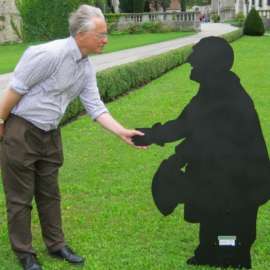Despite the accolades heaped upon the Berlin Philharmonic and Sir Simon Rattle’s performance and recording of this version of Bruckner’s 9th symphony with its unfinished finale, performances worldwide remain few and far between. Orchestral schedules are planned far in advance, so perhaps it’s early days yet, and maybe this UK première of the “Conclusive Revised Edition 2012” will be the first of many. But it was certainly an ambitious and courageous programme for Robert Dick and his orchestra to present as part of the Edinburgh Festival Fringe.
The Orchestra of the Canongait is described in the programme as “a healthy mixture of local professional and amateur musicians as well as students, all committed to the purpose of performing the great symphonic repertoire to the highest possible standards”. On the evidence of this concert, they achieve this ambition admirably, and were rewarded by a sell-out audience in this large ecclesiastical venue. The acoustic is better than that of many similar buildings, with a reverberation of about 3 seconds, and the orchestral sound was rich and full-bodied. The woodwind occasionally came through so strongly that they threatened to overwhelm the strings. This was especially apparent in Bruckner’s stamping Scherzo, where the contribution of the violins – their pizzicato dance – glinted like shards of mica on the thundering boulders of sound. The trio was played fast, with never a moment’s slowing down for the descending figures that lead so many conductors to retreat into sentimentally. It's so rare to hear it like this, and that alone made it worth the journey from London to Edinburgh (and back on the sleeper)! Even the fact that the strings found this trio somewhat challenging, at times producing a rather scratchy, thin sound, this only made it a touch scarier – no doubt to the players as well as the audience.
It was apparent from the start that Robert Dick took this vast symphony very seriously: he waited for silence, and for that silence to breed a deeper silence, before signalling the strings to commence their very quiet tremolo. The motivic fragments and noble horns calls that populate the long crescendo to its thunderous unison climax were articulated with clarity and precision – a clear exposition seemingly valued more than wafting impressionism, and the great climaxes when they came were shattering in their power. The second subject group had a melancholy calm to it, rather than the overcharged Mahlerian expressiveness that some interpreters favour, and therefore worked well as a foil to the stormier matter of the other themes. The orchestra followed Dick’s clear beat attentively, and he was able to indulge some very effective changes of tempo. They played as though possessed in the Scherzo, and the violins’ opening gesture in the Adagio – that agonised leap of a ninth – was attacked with a fervour reminiscent of the famous Schuricht recording with the Vienna Philharmonic.
When there’s a finale still to come, it is a mistake to make this Adagio too long, slow and valedictorian. Dick kept the music moving, but at times there were some problems with togetherness, and occasionally the violins lacked the finesse required for the quieter contrapuntal passages – a problem that also undermined the cogency of some parts of the finale. Nevertheless, when the immense triple forte dissonance came – the ultimate destination of all that chromatic striving that suffuses the Adagio – it was delivered to stunning effect. No lingering was permitted over the final pages, for, although over an hour had passed, this was not yet the end.
I’ve now heard quite a number of performances of the various performing versions of this finale – some more convincing than others. Overall this one worked well: the chorale splendid (it always is!), the fugue delivered with strength and clarity (it often isn’t), and the slow mysterious opening of the coda very effectively done. Some almost obsessional rhythms pervade the movement – the double-dotted jerking of the first and second themes, the skittering triplets that first appear accompanying the chorale – and I thought they failed to register as determinedly as they should, mainly a result of the acoustic, and from where I was sitting the trumpet fanfares of the last bars were only just audible. Even so, it was a stirring close to an immensely powerful performance.
Once, when I told someone I liked Bruckner, the reply came that they loved his violin concerto. Had they come to this concert, never again would they confuse Bruch and Bruckner. In the first half, Madeleine Mitchell gave a performance of the Bruch Violin Concerto that seemed powered by an almost daemonic intensity – totally bewitching. She has a full rich tone that sang strongly through the large church acoustic. Once in a while the orchestral tutti is called upon to present the big tune loud and clear, and they rose splendidly to the occasion; otherwise their accompaniment to Mitchell’s controlled but vibrant lyricism was discrete and veiled enough to allow her all the room she needed. A great performance of this romantic warhorse.


